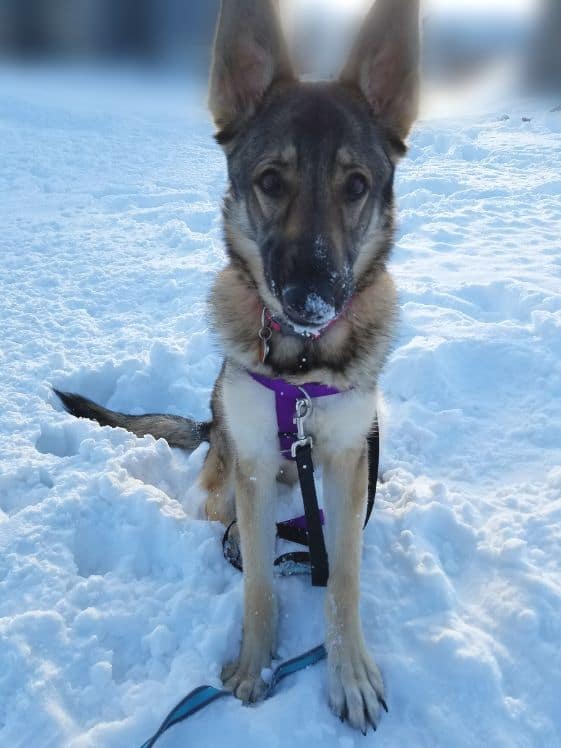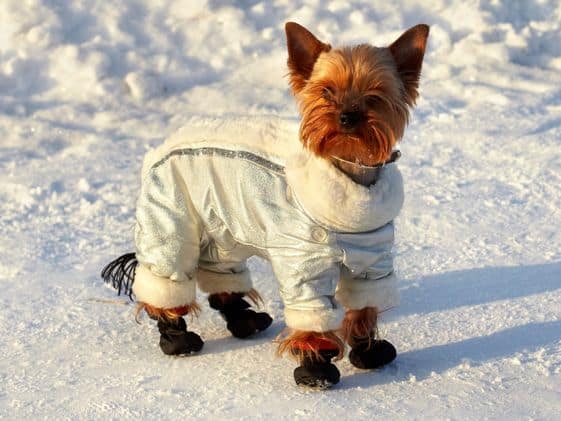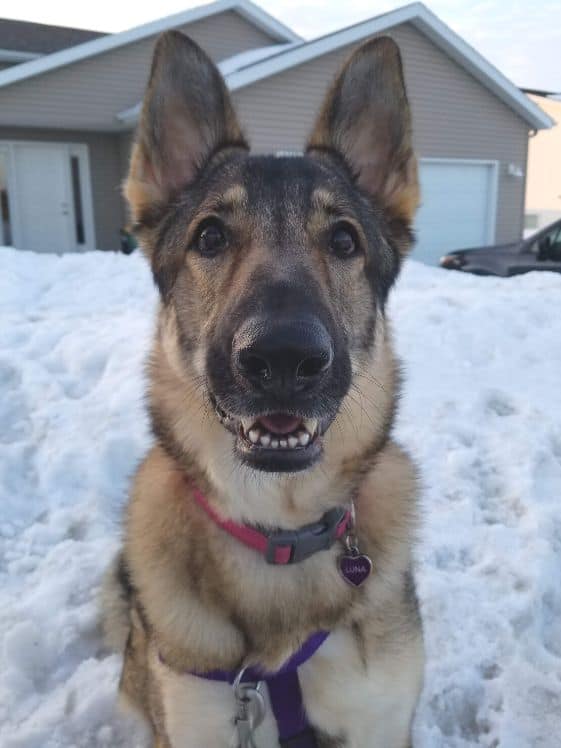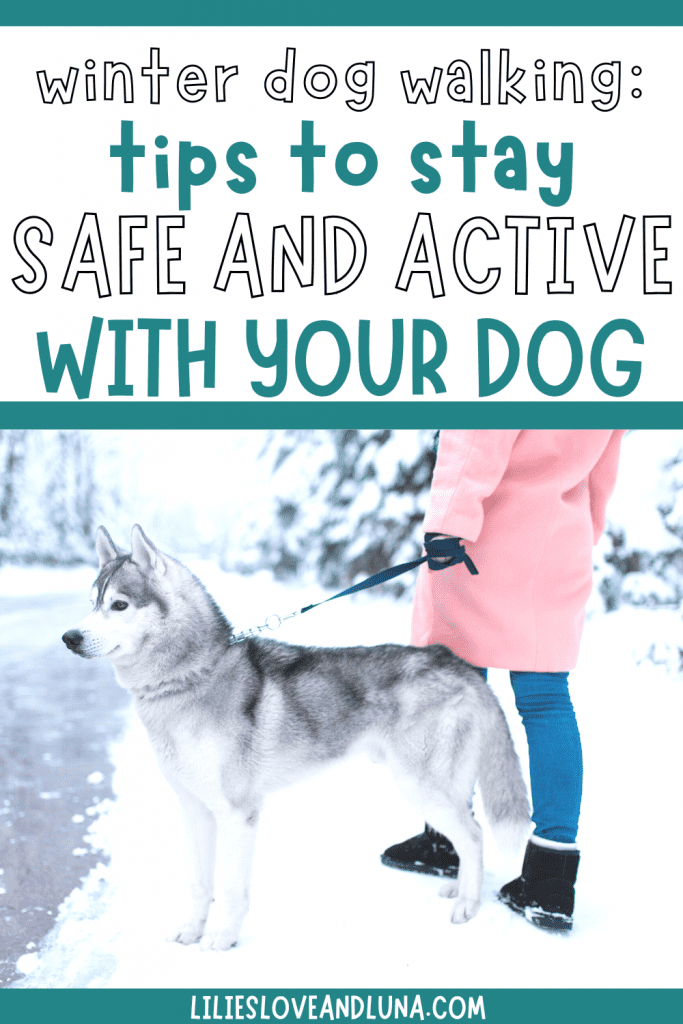Keep your furry friend safe this winter!
Just because the weather is chilly doesn’t mean you have to leave your dog at home. In fact, with a little preparation, you can keep them warm and safe on winter walks. Check out our tips below!
A happy, healthy dog is a well-protected dog. Make sure to keep your dog safe during these cold winter months.
Follow our tips to keep your furry friend warm and safe this winter!
This post may contain affiliate links. That means if you click on them and buy something, I may receive a small commission at no cost to you. Read my Disclaimer Policy to learn more.
Is it safe to walk my dog in the winter?

This is a question many pet parents ask themselves as the winter season approaches. While the low temperatures do bring new challenges and dangers for you and your dog, it is still safe to take regular walks with your dog in the winter.
Even though it is safe to walk in the winter, there are certain precautions you should take to ensure a safe and enjoyable winter walk for both you and your dog.
When is it too cold to walk your dog?
This answer will vary depending on your dog. Small dogs and those with short, thin fur will get cold faster than large, thick-furred dogs like Luna (a German Shepherd).
This advice also varies some on where you live. I know people in the south that say freezing temperatures are too cold to go for a walk with your dog. For me, living in North Dakota, if I didn’t take my dogs for walks in the cold temperatures, which for some is below 32°F, we wouldn’t be going for walks for up to 5 months straight.
I base my decision on when it’s too cold for a walk partly on whether we have a windchill advisory. If it’s not safe for me to be out more than 5 to 15 minutes without the potential for frostbite, I don’t take my dogs for a walk.
Generally, if the temperature is less than 0°F, don’t take your dog for a walk. Between 0 and 32°F use precautions and pay attention to your dog.
Can dogs walk in the snow barefoot?
It is best to not let your dog walk in the snow barefoot. The salt and other chemicals used to melt the snow and ice can irritate your dog’s paw pads. It is best to put booties on your dog or use a paw balm to protect their paws.
Walking without paw protection can also put your dog at higher risk of getting frostbite on their paws.
Do dogs need coats in winter weather?
Again, this will depend on your dog. Short-haired dogs will need a coat to help them stay warm in the winter weather.
Dogs that have fur that mats easily, like poodles, may also benefit from a coat to help keep their fur from matting.
What about indoor dog walking?
You can also walk your dog indoors if the weather is too cold or snowy outside. If you are lucky enough, there may be an indoor track near you that allows dog walking. Some areas also have indoor dog parks that may be an option.
If you don’t have either of these near you, there are some stores that allow dogs to come inside. Most pet stores are dog friendly and some other stores are as well. Just make sure to call ahead to make sure that location is dog friendly.
Winter walking safety tips for dogs
Now that you know it is safe to walk your dog in the winter, here are some tips to make sure you and your dog have a safe and enjoyable winter walk.
Check the weather conditions before heading out
This may seem like a no-brainer, but it is important to check the weather conditions before you head out for your walk. If the windchill is too low, or if it is snowing or freezing rain, it is best to wait for another day to walk.
Dress appropriately for the weather

Just like you need to dress appropriately for the weather, your dog will also need the right gear to stay warm.
For dogs that need a coat, make sure the coat is waterproof and covers their belly. You may also want to get a sweater or shirt for your dog to wear under their coat.
For all dogs, it is important to put booties on their feet to protect their paw pads from the salt and other chemicals used to melt the snow and ice.
Be aware of the hazards
When walking in the winter, be aware of the potential hazards. Avoid walking on icy sidewalks and streets. Be careful of areas that have been treated with salt or other chemicals. These can be irritating to your dog’s paw pads.
Also, be aware of other animals. In the winter, wildlife is more active and you may come across animals like squirrels, rabbits, or birds.
Look for cues in your dog’s behavior
Your dog will let you know if they are too cold or not enjoying the walk. If your dog starts to shiver, whine, or seems sluggish, it is time to head back inside.
Watch out for animal waste
Watching for animal waste is more important in the winter than in the summer. It seems like more people are willing to not pick up after their dogs in the winter because it’s cold out and they just want to get back home.
Also, in the winter, animal waste is more difficult to see due to the probability of it being covered with snow.
Keep your walk short
In the winter, it is best to take shorter walks with your dog. How short depends on your dog and the weather conditions.
This will help your dog stay warm and avoid getting too cold. You can always take a couple of short daily walks as long as you give your dog enough time to warm up between walks.
Keep toe hair clipped
For dogs that have hair between their toes, it is important to keep this hair trimmed. This will help prevent the hair from collecting snow and becoming ice-encrusted.
Wipe paws and belly when you get home
When you get home from your walk, it is important to wipe your dog’s paws and belly. This will help remove any salt, sand, or chemicals that may be on their paws and fur.
It also helps to remove any snow that is stuck to their fur and allows them to dry faster once you are inside.
Check your dog’s paw pads
After your walk, check your dog’s paw pads for any cuts or abrasions. If you find any, clean them with soap and water and apply a pet-safe ointment.
Also, check your dog’s pads for any signs of irritation from the salt or chemicals used to melt the snow and ice. If you find any irritation, wash your dog’s feet with soap and water.
Moisturize your dog’s paw pads
If your dog’s paw pads seem dry or cracked, you can apply a pet-safe balm or moisturizer, like paw wax, to their paw pads. This will help protect their paws from the harsh winter conditions.
Stick to the Sidewalk
When walking in the winter, it is best to stick to the sidewalk and stay out of the road as much as possible.
In areas that get a significant amount of snow, the roads tend to get narrow and the snow piles on the curb tend to get tall.
Between the narrower roads, tall snow banks, icy roads, and early darkness, you are much more likely to be hit by a car when walking in the street in the winter than in the summer.
Watch out for ice and salt
Be careful of ice and salt when walking your dog in the winter. Ice can be slippery and dangerous for you and your dog. Salt can also irritate your dog’s paw pads.
If you come across an icy spot, it is best to find another way around. If you must walk on the ice, go slowly and be careful.
Walk in the day
In the winter, it gets dark earlier. It is best to walk your dog during the daylight hours so you can see where you are going and avoid potential hazards.
If you must walk your dog at night, be sure to wear reflective gear and bring a flashlight.
Shovel snow and use pet-safe ice melt
Shovel any snow off of your sidewalk and porch before taking your dog for a walk. This will help prevent your dog from tracking snow and ice into the house. It also reduces the chances of falling when you don’t have snow to walk through.
If you use ice melt, be sure to use a pet-safe variety. Some ice melts can be harmful to pets if ingested.
Limit snow intake
Eating snow can cause stomach issues for dogs. It is best to limit how much snow your dog eats while walking.
If your dog must eat snow, make sure it is clean, fresh snow. Avoid areas where there may be animal waste or other contaminants.
Watch for frostbite
Frostbite is a serious risk in the winter. Be sure to watch for signs of frostbite, such as skin that is cold to the touch or has lost sensation, pale or gray skin, or blisters.
If you think your dog may have frostbite, seek veterinary care immediately.
Keep your dog leashed
In the winter, it is best to keep your dog on a leash. This helps you maintain control of your dog and avoid hazards.
In areas where there are a lot of people walking, keeping your dog leashed can also help prevent them from getting lost in the crowd.
It also reduces the chance of your dog running into the street when there is a car coming. With the typical tall snow pile, at least around here, a dog that runs into the street may not be seen in time to prevent an accident.
Make sure your dog’s ID is up-to-date

In case of an emergency, it is important that your dog’s ID tags are up-to-date. Be sure to check that the ID tag on your dog’s collar is readable and that the information on it is correct.
You should also make sure that your dog is microchipped and that the information associated with the microchip is up-to-date.
In case your dog does get lost, having a current ID will increase the chances of being reunited.
Avoid metal surfaces
When it is cold outside, metal surfaces can be very cold to the touch. Avoid walking your near metal surfaces, such as fire hydrants, benches, and fences.
A curious dog may decide to lick a metal surface and get frostbite on their tongue. Walking on a metal surface can be just as bad for their paws as licking a metal surface would be on their tongue.
Try alternative exercise
If it is too cold to walk outside, there are other ways to get your dog some physical activity indoors.
You can play indoor games, such as fetch or tug-of-war. You can also teach your dog tricks. Tricks require mental stimulation and can be a great way to tire out your dog without going outside.
Winter dog walking gear

To help keep yourself and your dog safe and comfortable during winter walks, there is some special gear you can use.
Winter coat
A good winter coat will help keep you warm when you are walking yoru dog. Look for a coat that is waterproof and windproof. If you will be walking in an area that gets really cold or windy, a coat with a hood will help to keep you warm.
Winter hat
A hat will help to keep your head warm and dry. If you have a hood on your coat, it is still a good idea to wear a hat underneath the hood. This will help to keep your head warm even if the hood blows off.
Waterproof insulated gloves
Walking a dog in the winter can be tough on your hands. The cold weather can make your hands dry and cracked. Wearing gloves will help to protect your hands from the elements.
It is also a good idea to find gloves that are waterproof. This will help to keep your hands warm and dry even if you have to shovel snow or walk in rain or slush.
Waterproof insulated boots
Walking in the winter can be tough on your feet. Be sure to wear boots that are comfortable and provide good support. It is also a good idea to find boots that are waterproof. This will help to keep your feet warm and dry even if you have to walk through snow or puddles.
Shoe ice and snow grips
If you are unable to avoid walking on ice or snow, it is a good idea to get shoe ice and snow grips. These fit over your shoes or boots and provide extra traction. This can help to prevent falls on slippery surfaces.
Dog boots
Just like people, dogs need protection for their feet in the winter. Be sure to put boots on your dog’s feet before taking them out for a walk.
Dog booties help to protect your dog’s paws from the cold and from salt and other chemicals that may be on the ground.
Dog coats and sweaters
Another way to help keep your dog warm is to dress them in a coat or sweater. Be sure to put the coat on your dog before taking them outside.
A dog coat will help to keep your dog’s body temperature regulated. This is especially important for short-haired dog breeds. A water-resistant coat will also help to keep your dog dry on your walk.
A warm sweater can also help to keep your dog from getting too cold. It is a good idea to put a sweater on your dog if they are going to be in the cold for an extended period of time.
Reflective gear for you and your dog
Reflective gear is important for both you and your dog in the winter.
Wearing reflective gear will help drivers see you in the dark or in low-light conditions. This is especially important on the shorter days of winter when it gets dark so early.
There are reflective vests you can wear and there are reflective leashes for dogs. Some harnesses and dog coats are also reflective.
If you can’t find reflective clothing that you like for yourself and your dog, there is also reflective tape that you can get to put on what you already wear.
Talk to your vet
If you are concerned about your dog being in the cold, be sure to talk to your veterinarian. They will be able to give you specific advice for your dog based on their health and breed.
Your vet may also recommend certain products that can help to keep your dog warm in the winter.
Conclusion
Winter weather can be tough on both humans and pets. But by following these tips, you can make sure your furry friend stays safe and warm during your winter walks.
Stay bundled up yourself, avoid icy sidewalks and streets, take care with chemicals and salt, and keep your pet’s ID updated just in case of an emergency.
By taking these precautions, you’ll have a happy (and safe) dog by your side this winter!
Related posts
Outdoor Winter Activities for Dogs
Tips for Protecting Your Dog’s Paws in the Winter





